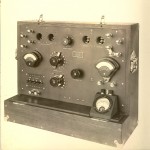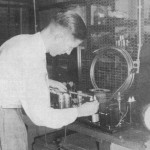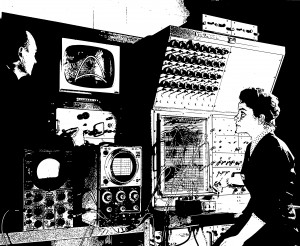Science Fiction Test 01
 The visiphone chimed when Peri had just gotten into her dinner gown. She peeled it off again and slipped on a casual bathrobe: a wisp of translucence which had set the president of Antarctic Enterprise—or had it been the chairman of the board?—back several thousand dollars. Then she pulled a lock of lion-colored hair down […]Read More »
The visiphone chimed when Peri had just gotten into her dinner gown. She peeled it off again and slipped on a casual bathrobe: a wisp of translucence which had set the president of Antarctic Enterprise—or had it been the chairman of the board?—back several thousand dollars. Then she pulled a lock of lion-colored hair down […]Read More »Gutenberg Test Post 02
 BOOK-PLATES of TO-DAY Edited By WILBUR MACEY STONE NEW YORK TONNELÉ & COMPANY 1902 Copyrighted 1902 by Tonnelé & Co. BOOK-PLATES OF TO-DAY TONNELÉ & COMPANY NEW YORK TABLE OF CONTENTS Book-plate of Mrs. Amy Ivers Truesdell, in colors. Designed by Jay Chambers. Frontispiece Book-plate of Arnold William Brunner, in colors. Designed by Thomas Tryon. […]Read More »
BOOK-PLATES of TO-DAY Edited By WILBUR MACEY STONE NEW YORK TONNELÉ & COMPANY 1902 Copyrighted 1902 by Tonnelé & Co. BOOK-PLATES OF TO-DAY TONNELÉ & COMPANY NEW YORK TABLE OF CONTENTS Book-plate of Mrs. Amy Ivers Truesdell, in colors. Designed by Jay Chambers. Frontispiece Book-plate of Arnold William Brunner, in colors. Designed by Thomas Tryon. […]Read More »Taken as a whole, the first fourteen years of the century, which my malicious friend Jean Cocteau sometimes calls l’époque héroïque, possessed most of the virtues and vices that such an epoch should possess. It was rich in fine artists; and these artists were finely prolific. It was experimental, and passionate in its experiments. It was admirably disinterested. Partly from the pressure of opposition, partly because the family characteristics of the Cézannides are conspicuous, it acquired a rather deceptive air of homogeneity. It was inclined to accept recruits without scrutinizing over closely their credentials, though it is to be remembered that it kept its critical faculty sufficiently sharp to reject the Futurists while welcoming the Cubists. I cannot deny, however, that in that moment of enthusiasm and loyalty we were rather disposed to find extraordinary merits in commonplace painters. We knew well enough that a feeble and incompetent disciple of Cézanne was just as worthless as a feeble and incompetent disciple of anyone else—but, then, was our particular postulant so feeble after all? Also, we were fond of arguing that the liberating influence of Cézanne had made it possible for a mediocre artist to express a little store of recondite virtue which under another dispensation must have lain hid for ever. I doubt we exaggerated. We were much too kind, I fancy, to a number of perfectly commonplace young people, and said a number of foolish things about them. What was worse, we were unjust to the past. That was inevitable. The intemperate ferocity of the opposition drove us into Protestantism, and Protestantism is unjust always. It made us narrow, unwilling to give credit to outsiders of merit, and grossly indulgent to insiders of little or none. Certainly we appreciated the Orientals, the Primitives, and savage art as they had never been appreciated before; but we underrated the art of the Renaissance and of the eighteenth and nineteenth centuries. Also, because we set great store by our theories and sought their implications everywhere, we claimed kinship with a literary movement with which, in fact, we had nothing in common. Charles-Louis Philippe and the Unanimistes should never have been compared with the descendants of Cézanne. Happily, when it came to dragging in Tolstoyism, and Dostoievskyism even, and making of the movement something moral and political almost, the connection was seen to be ridiculous and was duly cut.
The protagonists of the heroic epoch (1904—1914 shall we say?) were Matisse and Picasso. In modern European painting Picasso remains the paramount influence; of modern French, however, Derain is the chief; while Matisse, who may still be the best painter alive, has hardly any influence at all. In these early days Derain, considerably younger than Matisse and less precocious than Picasso, was less conspicuous than either; yet he always held a peculiar and eminent position, with an intellect apt for theoretical conundrums and sensibility to match that of any Fauve and his personal genius brooding over both. About the best known of Matisse’s companions—for they were in no sense his disciples—were, I should say, Friesz, Vlaminck, Laprade, Chabaud, Marquet, Manguin, Puy, Delaunay, Rouault, Girieud, Flandrin. I think I am justified in describing all these, with the exception, perhaps, of Girieud and Flandrin, as Fauves; assuredly I have heard them all so described. In very early days Maurice Denis was by some reckoned a chief, the equal almost of Matisse; but through sloppy sentiment he fell into mere futility, and by now has quite dropped out. Friesz, on the other hand, has gone ahead, and is to-day one of the half-dozen leaders: I shall have a good deal to say about him in a later part of this book. Vlaminck a few years ago had the misfortune to learn a recipe for making attractive and sparkling pictures; he is now, I understand, in retirement trying to unlearn it. Rouault is a very interesting artist of whom we see little; from what I have seen I should be inclined to fear that a taste for romance and drama is too often suffered to smother his remarkable gift for painting. Marquet, with gifts equal to almost anything, is content, it seems, to remain a brilliant but superficial impressionist. Puy is a thoroughly sound artist, and so in a smaller way is Manguin. What has become of Chabaud, who was a bit too clever, and a little vulgar even? And what of Delaunay? And of Flandrin—what has become of him? Something sufficiently interesting, at any rate, to give pause even to a critic in a hurry. His name must not go by unmarked. Flandrin was amongst the first to rebel against Impressionism—against that impressionism, I mean, which remained implicit in post-impressionism. Resolutely he set his face against the prevailing habit of expressing an aspect of things, and tried hard to make a picture. So far he has succeeded imperfectly: but he is still trying.

